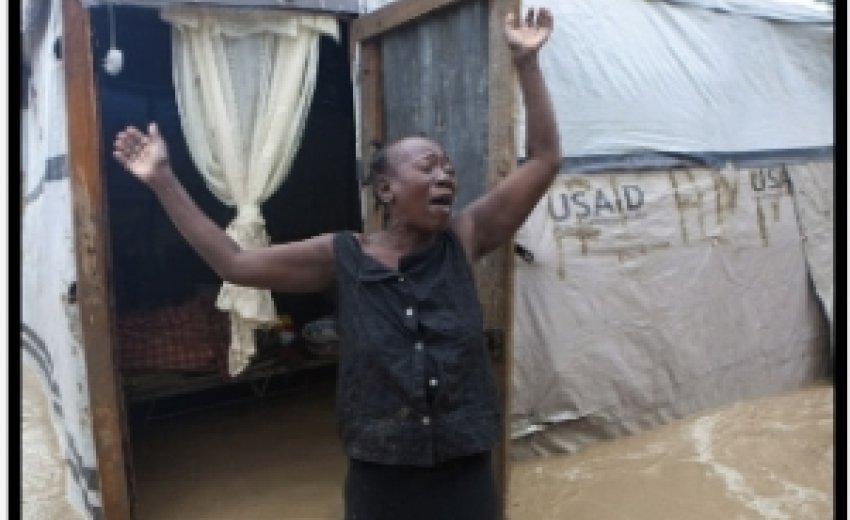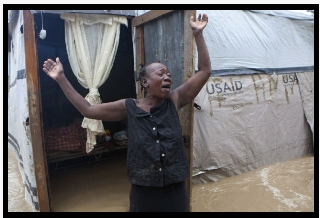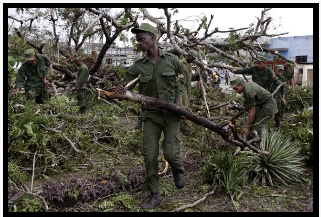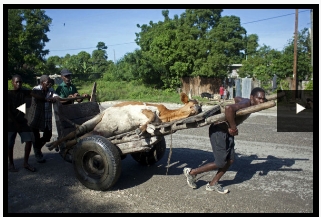In the two hard-hit countries, where Hurricane Sandy caused 66 deaths, residents are coping with life without electricity and water. In Santiago de Cuba alone, some 137,000 homes were damaged.
| Even before Hurricane Sandy tore through Santiago de Cuba last week, a humble wood-frame church called San Pedrito was living on borrowed time with beams ravaged by termites and an ancient tin roof that let in the rain.
But San Pedrito crumbled Thursday as Sandy’s 115 mph winds ripped Cuba’s second largest city. “It is totally on the ground, but we were able to recover the statue of Our Lady, the crucifix and the bell,’’ said the Rev. Luis del Castillo, a retired Uruguayan bishop who now works in Cuba. There is scarcely any area of Santiago that was left unscathed. Photos show neighborhoods that look like trash piles of construction materials with wood beams tossed like toothpicks and tin roofs and tiles scattered on the ground. Walls of some homes lean at crazy angles or tilt toward streets still littered with huge trees. As Sandy bore down on the U.S. East Coast on Sunday, the two hardest hit Caribbean nations — Cuba and Haiti — concentrated on trying to put together what Sandy tore apart. In Cuba, where the death toll stood at 11, state-run media reported that 137,000 homes in Santiago were damaged, including 43,000 that lost their roofs and at least 15,000 that collapsed. Government estimates pegged losses at 2.1 billion pesos ($2.1 billion at the official rate Cuba uses for imports and $87.5 million using the exchange rate for everyday purchases in Cuba). But that figure is expected to rise when losses from tourism, the sugar industry and other sectors are added in. In Holguín province where Sandy exited Cuba, the Cuban News Agency said that 17,000 homes suffered damage and there were significant losses to crops and livestock. The municipalities of Mayari, Banes, Antilla, Rafael Freyre, Baguano, Urbano Noris, Sagua de Tanamo and Cueto were among the hardest hit. But Sandy also brought driving rain, which caused severe flooding in the central Cuba provinces of Villa Clara and Sancti Spíritus. Cuban leader Raúl Castro visited them Saturday and has said he intends to travel to eastern Cuba as well. “We can say that we have had a great hurricane in the east and a small ‘Flora’ (a destructive 1964 hurricane) in the center of the country,” said Castro, according to the state-run National Information Agency. Haitian President Michel Martelly also was on the streets of his devastated country over the weekend, personally handing out aid kits. Hundreds of residents from the Jalousie slum crowded a Petionville street mid-afternoon Sunday for the arrival of Martelly and a truck carrying the kits, which included candles, spaghetti and other foodstuffs. In Haiti, 51 people were reported dead and 15 missing. More than 200,000 people were homeless and nearly 17,200 people had been placed in shelters. The government was serving hot meals and handing out $25 cash vouchers to shelter residents in the city of Les Cayes in southwest Haiti. Damages were still being tallied Sunday and the death toll could rise. Officials from Les Anglais, a small coastal village in southern Haiti, told a local radio station they feared homes may have washed out to sea. The road to the village remains impassable. Another concern in Haiti is that cholera cases may increase. The International Organization for Migration reported that 16 new cases had already been recorded since Sandy’s pass. In Cuba, residents described how people were coping with the aftermath of the hurricane that came ashore on a beach southwest of Santiago and swept north across the eastern part of the island. The Army has been clearing the streets and removing trees that have toppled electrical poles and wires, but most of the city remains without power, water or telephone service, said del Castillo, who was reached via an Internet connection over the weekend. State-run media said that electricity had been restored to about 80 percent of those who lost power in Holguín, but restoration was proving more complicated in Santiago where 72 work brigades from around the country were working on returning electricity. |
|
|
“The churches in Santiago are in very bad shape — some are just rubble; others have lost their roofs,’’ said del Castillo. “We will celebrate mass in the streets.’’ For a country that was officially atheist until 1992, there was already a shortage of churches and priests before Sandy hit. Now, del Castillo said he expects the church’s Casa del Misión (Mission House) program to expand. Under the mission house concept, parish priests and nuns travel a circuit to communities without priests and religious activities are held in people’s homes or makeshift facilities. But he added, “The priority isn’t the church buildings; it is the people.’’ In a city known for its hospitality as well as for being the cradle of the revolution, neighbors, even small children who are clearing branches, have pitched in to help those with less, he said. “People are just happy they’re alive and they’re concentrating on rebuilding and how they can help each other,’’ said del Castillo. With windows smashed and without power, many stores are closed and food supplies are difficult, he said. Those who have food are sharing with neighbors and cooking on wood fires in the streets. State-run media said the government was shipping in food, including bread, from nearby provinces. Some food, said del Castillo, also has begun to arrive via Caritas, the Catholic relief organization in Cuba. Catholic Charities of the Archdiocese of Miami is working with Caritas and Catholic Relief Services to help those in the areas most affected by Sandy. It is accepting monetary donations through its website (www.ccadm.org) but is not calling for food donations at this point. Schools have been closed since Thursday in Santiago and many that remain intact are being used to house the homeless. Del Castillo said he has two families that are staying at his church, The first shipment of 12,000 roofs arrived in Santiago on Saturday via train, according to the website of Sierra Maestra, a provincial newspaper. The government said that was the first wave of shipments of some 84,000 roofs and 220,000 tons of cement expected to arrive in the province via train and ship. | |






